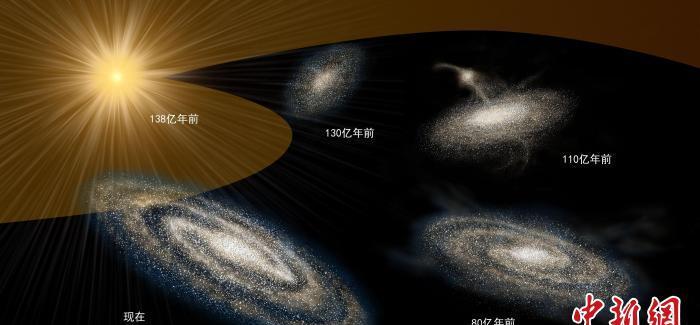
Schematic diagram of early integration and evolution of the Milky Way. Yu Jingchuan draws photography
Beijing, March 24 (China News Network) (Reporter Sun Zifa) How old is the Milky Way Galaxy? How did it come into being and evolve? The internationally renowned academic journal "Nature" published the latest research results of astronomers in the form of a cover article on March 24, Beijing time, pointing out that the Milky Way may have gone through different stages of evolution, and its starting point was the formation of pan groups of stars about 13 billion years ago.
March 24 Issue Of Nature Cover - Starcatcher's Guide to the Galaxy. Courtesy of the National Astronomical Observatories of the Chinese Academy of Sciences
The result of this major astronomical study, which comes from an accurate calculation of the age of nearly 250,000 stars, was done in collaboration with Dr. Mao Sheng and Professor Hans-Walter Rix at the Max Planck Institute for Astronomy in Germany. Based on the sky survey observation data of the Guo Shoujing Telescope (LaMost), a major national scientific and technological infrastructure operated by the National Astronomical Observatory of the Chinese Academy of Sciences, and gaia telescopes of the European Space Agency's astrometry satellite, they obtained the most accurate large sample of star age information to date, clearly restored the formation and evolution of the Milky Way in infancy and adolescence according to the time series, and rewrote people's understanding of the early formation history of the Milky Way.
To study the history of the Formation of the Milky Way, the two astronomers identified about 250,000 stars in the subgiant stage from telescope survey data, which make up a large part of the Milky Way.' They estimated the individual ages of these stars to range from 1.5 billion to 13.8 billion years, and then confirmed and characterized the origin of different structural elements in disk and halo stars, showing that the formation of the Milky Way's thick disk began about 13 billion years ago, only 800 million years later than the Big Bang.
The latest research shows that in terms of time, the integration and evolutionary history of the Milky Way is divided into two distinct stages, from the early stages from 13 billion years ago to 8 billion years ago and the late stages from 8 billion years ago to the present, the early stages forming the thick disks and silver halos of the Milky Way, and the late stages forming the thin disks of the Milky Way.
Nature published a "News and Opinions" article by American astronomers at the same time that the age, composition and motion of the stars in the study reflect the dynamic process of the formation of the Milky Way, and more data will bring a larger sample size of stars in the Milky Way, making people's understanding of the formation of the Milky Way more and more clear.
According to the National Astronomical Observatory of the Chinese Academy of Sciences, in this study on the origin and evolution of the Milky Way, Guo Shoujing telescope released tens of millions of stellar spectral data, which has become the cornerstone of the digital Milky Way, and the Gaia satellite provides a map of the position and movement of 1.4 billion stars, which provides a unique advantage for astronomers to trace the integration and evolution history of the Milky Way.
At the same time, thanks to the Guo Shoujing Telescope Milky Way Sky Survey and other international sky survey projects, the age of obtaining large samples of stars has gradually become a reality in the past few years. The latest study is also the first time to obtain such a large sample of the high-precision age of stars in the vast space range of the Milky Way and the metal abundance of stars, successfully breaking through the limitations of the data and taking a landmark step for the study of the formation and evolution history of the Milky Way. (End)